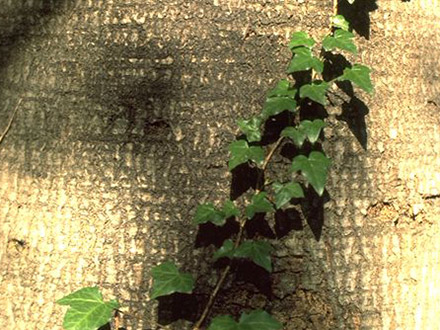Botanical name
(Common) Ivy - Hedera helix L.
Family
Ivy family (Araliaceae)
Common name
Ivy, Common ivy, English ivy, Glacier ivy
Information about the plant
The evergreen ivy is native to Europe and grows as a vine on trees and shrubs in forests and parks. It covers walls and shady corners in the big cities as well as in villages. Ivy is easy to recognise through its characteristically shaped leaves. It can be found in numerous cultivated and garden forms.
The genus name Hedera probably comes from the Greek ‘hedra’ (sitting), referring to the adhesion of the plant to the walls and trees. The epithet helix, from the Greek ‘helix’ (spiral), describes the winding of the ivy around trees. The German word Efeu probably goes back to an old word stem 'ebah' or 'ifig', which means "climber". This word stem was then combined with "heu", Old High German 'ep-höu' or 'ebe-höu'.
Ivy is a creeping or climbing, extremely woody, and branched plant. It clings to its support with adventitious roots. The leaves of the non-flowering shoots, characteristically have 3 to 5 lobes with a heart-shaped base; they are leathery, dark green, glossy, and often with lighter venation. The leaves on the flowering shoots are rhombic to lanceolate and tapered. The brown flowers are inconspicuous and in semi-globular clusters, like grapes. The flowering time is from September to October. The fruits ripen the following year. The blue-black berries are in decorative, spherical umbels. They go well in flower bouquets and flower arrangements. Caution: the berries can cause poisoning in children!
Medicinally used parts of plants (herbal drug)
The dried leaves harvested in spring (Ivy leaves - Hederae folium) are used. The drug is imported from Eastern European countries.
Constituents of the herbal drug
Ivy leaves contain triterpenoids, mainly hederacoside, flavonoids, caffeic acid derivatives, and sterols.
Quality of the drug
The quality of the following drugs or drug preparations is specified in the European Pharmacopoeia (Ph. Eur.):
- Ivy leaves (Hederae folium)
- Hedera helix for homeopathic preparations
Medical applications
Recognised medical use
The HMPC describes the following ivy leaf preparations for accepted medicinal use ("well-established use"): A: dry extract (DER 4-8:1, extractant ethanol 24-30%), B: dry extract (DER 6-7:1, ethanol 40%), C: dry extract (DER 3-6:1, ethanol 60%), D: fluid extract (DER 1:1, ethanol 70%), E: soft extract (DER 2.1-2.9:1, ethanol 50% with 2% propylene glycol added). The intended use for preparations A to E is as a mucolytic agent (expectorant) for productive coughs.
ESCOP: for coughs, especially if accompanied by excessive secretion of thick mucus; supportive treatment of inflammatory bronchial diseases.
Indications proven by clinical studies (approval): to alleviate the symptoms of chronic inflammatory bronchial diseases; colds of the respiratory tract.
Traditional use
Not applicable
Herbal drug preparations in finished dosage forms
- Dried extracts in tablets, effervescent tablets and soluble instant teas
- Dried extracts dissolved in juice, drops and other liquids
- Fluid extract in juice
- Tincture in drops
- Hedera helix homeopathic mother tincture in juices
Dosage
Prepared drugs: see patient information leaflet.
Tea infusion: infusions of ivy leaves are not common. In this case, finished medicinal products should be taken in order to benefit from the effectiveness of the ivy leaves.
Preparation of a tea
Not applicable
Notes
Ivy leaves should not be taken with existing gastritis and stomach ulcers.
There are no studies on the harmlessness of using ivy leaves during pregnancy and breast-feeding. Ivy leaves should not be used in children under 2 years old, as it may worsen the respiratory symptoms, medical advice should be sought for use in children aged between 2 and 4 years. Similarly, seek medical advice for shortness of breath, fever, or purulent sputum. Simultaneous administration with antitussives (cough medicines), such as codeine or dextromethorphan, should only be done under medical supervision.
Side effects
Sensitive individuals may experience stomach and intestinal complaints.
Interactions
None known
References
Herbal drug monographs
Further literature
Commentary on the European Pharmacopoeia(Ivy leaves, Nr. 2148; Hedera helix for homeopathic preparations, Nr. 2092)


